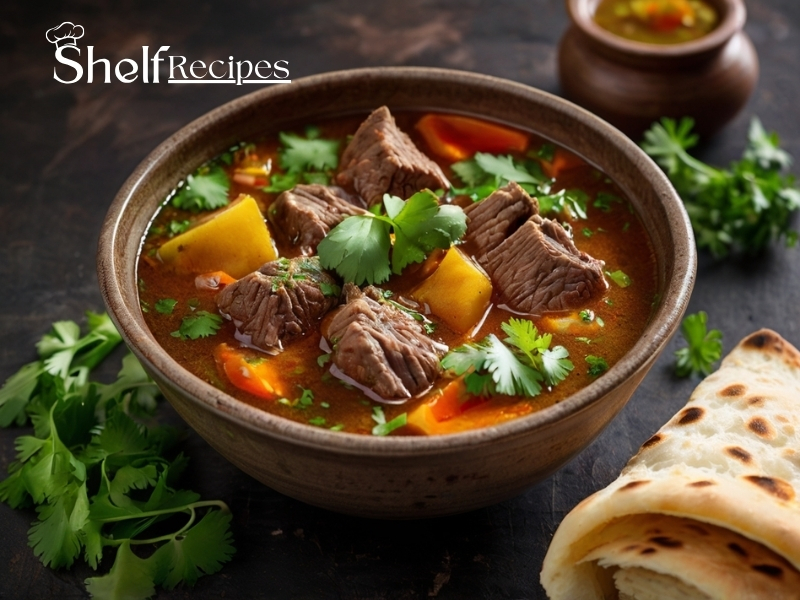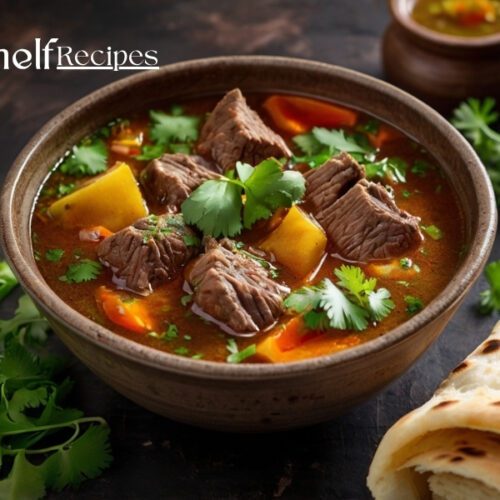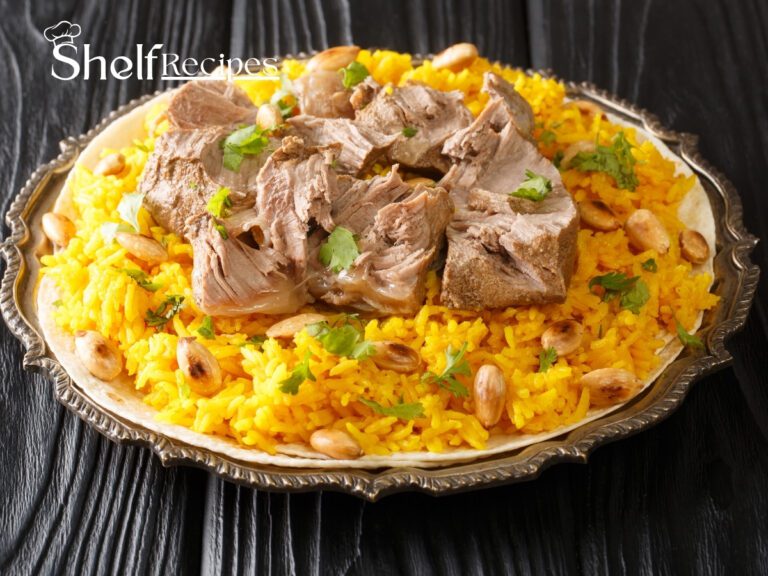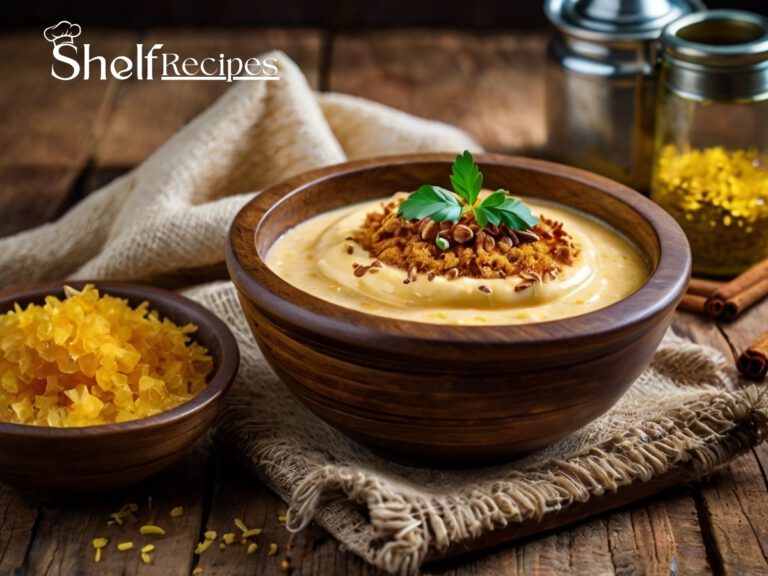
Introduction to Thareed
Thareed is one of the most beloved traditional dishes in Saudi Arabia, deeply rooted in Arabian cuisine and culture. This hearty meal consists of tender meat, slow-cooked vegetables, and rich broth served over crispy or soft bread, allowing the flavors to meld perfectly. Thareed is not only a staple during Ramadan but also a favorite comfort food families enjoy throughout the year.
Whether you are looking for an authentic Saudi Arabian recipe or want to try a new Middle Eastern dish, this Thareed recipe is a must-try!
What is Thareed?
Thareed is a centuries-old dish that dates back to the time of the Prophet Muhammad (PBUH), who praised it as one of the best meals. It is prepared by cooking meat—usually lamb or chicken—with vegetables such as potatoes, carrots, and zucchini in a well-seasoned broth. The dish is then poured over regag bread, which soaks up the flavorful liquid while maintaining a slight crunch.
Historical Background of Thareed
Origins in Pre-Islamic Arabia
Thareed (also spelled Tharid), a traditional bread soup dish, has its roots in the Arabian Peninsula, predating the rise of Islam. Originating among the nomadic Bedouin tribes, Thareed emerged as a simple, practical meal suited to their lifestyle. Made from crumbled flatbread (typically unleavened and often stale) soaked in a broth or stew, it was an efficient way to utilize available resources like bread, meat, and vegetables. The dish’s simplicity and portability made it a staple for the region’s desert-dwelling communities, reflecting their resourcefulness and adaptability.
Development in Early Islamic Period
Thareed gained significant cultural and religious importance in the early 7th century with the advent of Islam in Mecca, located in modern-day Saudi Arabia. It is widely recognized as a favorite dish of the Prophet Muhammad, who praised its virtues in several hadiths (narrations of his sayings). One notable hadith states that Thareed surpasses all other dishes, likening its superiority to that of Aisha, his wife, over other women. This endorsement elevated Thareed from a humble Bedouin meal to a dish of spiritual significance, symbolizing simplicity, sustenance, and communal eating—values central to early Islamic teachings.
Evolution and Spread in Saudi Arabia
As Islam spread across the Arabian Peninsula and beyond after the Prophet’s death in 632 CE, Thareed became a mainstay in Saudi Arabian cuisine, particularly in the Hejaz region around Mecca and Medina. Over time, it evolved from a basic dish of bread and broth into a more elaborate preparation, often incorporating meat (lamb or beef), vegetables (like potatoes, carrots, and zucchini), and spices influenced by trade routes connecting Arabia to India, Persia, and beyond. In Saudi Arabia, Thareed is especially associated with Ramadan, where it is commonly served to break the fast, reflecting its historical role as a nourishing, communal meal.
Cultural Significance and Modern Adaptations
Thareed remains a symbol of Saudi Arabian heritage and Arab identity, rooted in its pre-Islamic origins and Islamic endorsement. While traditionally served over flatbread like regag or khubz, modern variations may include rice or other grains, reflecting contemporary tastes and dietary preferences. Its preparation has also adapted to include healthier cooking methods, such as baking instead of frying, and plant-based meat alternatives, aligning with modern nutritional trends. Today, Thareed is celebrated not only in Saudi Arabia but across the Arab world, with regional variations in places like the UAE, Bahrain, and North Africa (where it’s known as “trid”), showcasing its enduring legacy and adaptability.

Thareed
Ingredients
For the Meat and Broth:
- 1 kg lamb or chicken cut into medium pieces
- 2 tablespoons vegetable oil
- 1 large onion chopped
- 3 cloves garlic minced
- 2 large tomatoes chopped
- 1 tablespoon tomato paste
- 1 teaspoon ground cumin
- 1 teaspoon ground coriander
- 1 teaspoon black pepper
- 1 teaspoon turmeric
- 1 teaspoon cinnamon
- 1 teaspoon salt adjust to taste
- 4 cups water or broth
- 2 dried black limes loomi (optional)
For the Vegetables:
- 2 large carrots cut into chunks
- 2 potatoes peeled and cubed
- 1 zucchini sliced
- 1 bell pepper chopped
For Serving:
- 3-4 pieces of regag bread or thin Arabic bread
- Fresh cilantro for garnish
Instructions
Step 1: Sauté the Meat
- In a large pot, heat the vegetable oil over medium heat.
- Add the chopped onions and sauté until golden brown.
- Stir in the minced garlic and cook for another minute.
- Add the lamb or chicken and cook until browned on all sides.
Step 2: Build the Flavor
- Stir in the chopped tomatoes and tomato paste, mixing well.
- Add cumin, coriander, black pepper, turmeric, cinnamon, and salt.
- Mix well and let the spices coat the meat for a minute.
Step 3: Simmer the Broth
- Pour in the water or broth, making sure the meat is fully submerged.
- Add dried black limes (if using) for extra depth of flavor.
- Cover the pot and let it simmer for about 45 minutes (or until the meat is tender).
Step 4: Add the Vegetables
- Add the carrots and potatoes first since they take longer to cook.
- After 15 minutes, add the zucchini and bell pepper.
- Let everything cook until the vegetables are tender (about 15 more minutes).
Step 5: Assemble the Thareed
- Tear the regag bread into large pieces and place them in a serving dish.
- Ladle the hot broth, meat, and vegetables over the bread, allowing it to soak in the flavors.
- Garnish with fresh cilantro and serve warm.
Equipment Needed
- Large cooking pot
- Wooden spoon for stirring
- Sharp knife for chopping vegetables
- Cutting board
- Ladle for serving
Tips for the Best Thareed
- Opt for Homemade Broth for a Richer Taste: Crafting your own broth using lamb bones, onions, garlic, and a touch of Saudi spices like black lime (loomi) and cardamom is a game-changer for authentic Thareed. Simmer for 3-4 hours to extract deep flavors, far superior to plain water or store-bought alternatives. A slow-cooked broth enhances the dish’s soul-warming essence, a hallmark of Saudi comfort food.
- Master the Bread’s Broth Absorption: In Saudi Thareed, the bread—often thin regag or crumbled khubz—is the heart of the dish. Tear it into pieces and layer it in a wide serving bowl, then pour hot broth over it gradually. Let it soak for 2-3 minutes to soften, but avoid over-saturation—aim for a tender yet slightly chewy texture that holds up under the stew, preserving the traditional mouthfeel.
- Choose the Right Protein: Lamb is the classic choice in Saudi Thareed, prized for its rich, tender texture when slow-cooked with spices like cinnamon and cloves. Opt for bone-in cuts (like shank) and cook until the meat falls apart. For a lighter twist, chicken thighs or drumsticks work beautifully—simmer until juicy but not overdone, keeping the dish versatile for all seasons.
- Adjust Spice Levels to Your Preference: Saudi Thareed typically features a warm spice blend with black pepper, turmeric, and dried lime, but you can personalize it. Add a pinch of chili flakes or a small green chili for a subtle kick, reflecting regional variations. Taste as you cook, ensuring the spices complement the broth without overwhelming the delicate bread and meat flavors.
- Toast Spices for Enhanced Aroma: Before adding broth, lightly toast whole spices like cinnamon sticks, cardamom pods, and cloves in ghee or oil for 30 seconds. This Saudi-inspired technique releases their oils, infusing the dish with a fragrant depth that’s central to the cuisine. Watch closely to avoid burning for the best results.
- Incorporate Vegetables with Care: Traditional Saudi Thareed often includes carrots, potatoes, and tomatoes. Cut them into large chunks to withstand the long simmer without dissolving. Add a handful of fresh parsley or cilantro at the end for a burst of color and flavor, aligning with Saudi garnishing customs.
- Build a Flavorful Base: Start with a base of sautéed onions and garlic, cooked until golden in ghee, to anchor the dish’s taste. This step is a Saudi cooking staple, adding sweetness and depth that ties the broth, meat, and bread together harmoniously.
- Serve Fresh for Optimal Texture: Thareed shines when served immediately after assembling. Pour the hot stew over the bread just before eating to maintain a balance of soaked yet intact bread, tender meat, and vibrant broth. Delaying service can lead to a mushy consistency, detracting from the authentic experience.
- Pair with Traditional Sides: In Saudi Arabia, Thareed is often enjoyed with a side of fresh salad (like a cucumber and tomato mix) or a dollop of labneh to balance its richness. This combination reflects local dining habits, offering a refreshing contrast to the hearty stew.
- Enhance with Authentic Garnishes: Elevate your Thareed with a sprinkle of toasted almonds or a drizzle of extra ghee, common in Saudi presentations. A few fresh mint leaves can also add a modern twist while honoring the region’s love for fresh herbs, making the dish visually and tastefully appealing.
- Use Quality Bread for Tradition: Opt for freshly made Saudi regag or a sturdy flatbread like khubz. Avoid soft sandwich bread, as it disintegrates too quickly. The bread’s texture is key to Thareed’s identity, soaking up the broth while providing a satisfying bite.
- Simmer Low and Slow: Cook the stew on a low heat for 1.5-2 hours to meld the flavors of meat, spices, and vegetables. This slow process, a Saudi cooking tradition, ensures tender meat and a cohesive broth that soaks into the bread perfectly.
The Cultural Significance of Thareed in Saudi Arabia
Thareed is often associated with Ramadan due to its wholesome and satisfying nature. It provides energy while being easy to digest, making it a favorite dish for iftar. Historically, it has been a dish of the rich and poor alike, appreciated for its simplicity yet incredible depth of flavor.
Here’s a concise overview of the Nutritional Benefits of Thareed, the traditional Saudi Arabian bread soup dish, broken into sections for clarity
Nutritional Benefits of Thareed
Balanced Macronutrients
- Carbohydrates: The flatbread (e.g., regag or khubz) provides complex carbohydrates, offering a steady source of energy to fuel daily activities. Whole grain versions, if used, increase fiber content, aiding digestion and blood sugar regulation.
- Protein: Meat (commonly lamb or beef) in Thareed is a rich source of high-quality protein, essential for muscle repair, immune function, and overall growth. Plant-based versions with legumes (e.g., lentils or chickpeas) also provide protein and fiber.
- Fats: Healthy fats from olive oil or meat contribute to satiety and provide energy. Using lean meats or plant-based oils can reduce saturated fat content, supporting heart health.
Vitamins and Minerals
- B Vitamins: Meat and bread supply B vitamins, particularly B12 (from meat) and B1 (thiamine from bread), which support energy metabolism and neurological health.
- Iron: Red meats like lamb or beef are excellent sources of heme iron, crucial for oxygen transport in the blood and preventing anemia. Plant-based versions with legumes offer non-heme iron, enhanced by pairing with vitamin C-rich foods.
- Potassium and Magnesium: Vegetables like potatoes, carrots, or zucchini (often included) provide potassium and magnesium, supporting heart function, muscle health, and blood pressure regulation.
Fiber and Digestive Health
- Vegetable Fiber: The inclusion of vegetables such as onions, carrots, or zucchini adds dietary fiber, promoting healthy digestion, regular bowel movements, and gut microbiome health.
- Whole Grains: If whole grain bread is used instead of refined flour bread, Thareed becomes an even better source of fiber, which helps maintain satiety and supports long-term digestive health.
Hydration and Satiety
- Broth Benefits: The broth or stew base of Thareed provides hydration, especially beneficial in the arid climate of Saudi Arabia or during Ramadan fasting. It also enhances satiety, helping you feel full longer and reducing overeating.
- Low-Calorie Density: When prepared with lean meats, minimal oil, and plenty of vegetables, Thareed can be a nutrient-dense, low-calorie meal, making it suitable for weight management.
Cultural and Functional Benefits
- Communal Nutrition: Traditionally served family-style, Thareed encourages mindful eating and portion control, fostering a balanced intake of nutrients in a social setting.
- Adaptability: Modern variations can boost nutrition further—using olive oil instead of ghee reduces saturated fat, while adding leafy greens (e.g., spinach) or legumes increases vitamins, minerals, and antioxidants.
Serving Suggestions
Traditional Presentation
- How to Serve: Serve Thareed in a large communal dish with the flatbread (e.g., regag or khubz) layered at the bottom, topped with the rich broth or stew. Encourage diners to scoop it up with their hands or spoons for an authentic experience.
- Garnish: Sprinkle fresh parsley, cilantro, or green onions on top for a burst of flavor and color.
Side Pairings
- Salads: Pair with a simple Saudi salad like fattoush or a cucumber-tomato salad with lemon and olive oil to add freshness and crunch.
- Pickles: Serve with pickled vegetables (e.g., pickled turnips or cucumbers) for a tangy contrast to the rich stew.
- Yogurt: Offer a side of plain yogurt or laban (a traditional fermented milk drink) to balance the dish’s warmth and add probiotics.
Beverage Companions
- Drinks: Serve with Arabic coffee (qahwa) or a chilled glass of tamarind juice, popular in Saudi Arabia, to complement the meal and aid digestion.
Occasion-Specific Serving
- Ramadan Special: Present Thareed as an iftar dish to break the fast, alongside dates and a light soup like lentil or vegetable soup, providing a nourishing and hydrating meal.
Variations to Try
Spicy Twist
- Variation: Add chili peppers, harissa, or a pinch of red pepper flakes to the broth for a spicy kick. Incorporate spices like cumin or coriander for extra depth.
- Tip: Balance the heat with a dollop of yogurt or a sprinkle of fresh herbs.
Veggie Boost
- Variation: Mix in additional vegetables like spinach, kale, eggplant, or bell peppers to increase fiber, vitamins, and color.
- Tip: Sauté the vegetables with onions and garlic before adding to the stew for enhanced flavor.
Protein Swap
- Variation: Replace lamb or beef with chicken, fish, or plant-based proteins like lentils, chickpeas, or tofu for a lighter or vegetarian option.
- Tip: For fish, use a firm variety like cod or haddock and add it near the end of cooking to prevent overcooking.
Grain Alternative
- Variation: Swap the flatbread for rice, bulgur, or quinoa for a different texture and nutritional profile. Whole grains add fiber and make the dish heartier.
- Tip: Cook the grains separately and layer them under the stew, or mix them in at the end.
Creamy Enrichment
- Variation: Stir in a small amount of cream, coconut milk, or a dollop of labneh (strained yogurt) to the broth for a richer, creamier texture.
- Tip: Add this just before serving to avoid curdling, and adjust seasoning as needed.
Global Fusion
- Variation: Experiment with international flavors—add curry powder for an Indian twist, harissa and preserved lemon for a North African flair, or soy sauce and ginger for an Asian-inspired version.
- Tip: Pair with complementary sides like naan (for Indian) or couscous (for North African) to complete the fusion experience.
Healthier Adaptation
- Variation: Bake the bread instead of frying it, use lean meats or plant-based proteins, and reduce oil by using a non-stick pot or broth-heavy preparation.
- Tip: Increase the vegetable-to-meat ratio for a lighter, nutrient-dense meal.
Similar Traditional Dishes You May Like
- Kuwaiti Tashreeb – Another Middle Eastern bread-based stew with a unique Kuwaiti touch.
- Saudi Jareesh – A comforting cracked wheat dish cooked with spices and meat.
- Emirati Harees – A slow-cooked wheat and meat dish perfect for Ramadan.
Final Thoughts
Saudi Thareed is a must-try dish that brings together the warmth of tradition and the richness of Arabian flavors. Whether you’re making it for a family gathering or simply exploring Saudi cuisine, this dish is sure to leave an impression.
💬 Have you tried Thareed before? What’s your favorite way to enjoy it? Let us know in the comments!
Don’t forget to check out more on our Ramadan recipes page from different countries!






